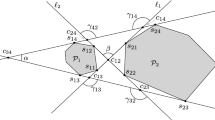Abstract
Let C be a compact set in ℝ2 and let S be a set of n points in ℝ2. We consider the problem of computing a translate of C that contains the maximum number, κ*, of points of S. It is known that this problem can be solved in a time that is roughly quadratic in n. We show how random-sampling and bucketing techniques can be used to develop a near-linear-time Monte Carlo algorithm that computes a placement of C containing at least (1 - ɛ)κ*. points of S, for given ɛ > 0, with high probability. We also present a deterministic algorithm that solves the ?-approximate version of the optimal-placement problem and runs in O((n 1+δ+ n/ɛ) logm) time, for arbitrary constant δ > 0, if C is a convex m-gon.
Agarwal was supported by NSF grants ITR-333-1050, EIA-9870724, EIA-9972879, CCR-00-86013, and CCR-9732787, and by a grant from the U.S.-Israeli Binational Science Foundation. Sharir was supported by NSF Grants CCR-97-32101 and CCR- 00-98246, by a grant from the Israel Science Fund (for a Center of Excellence in Geometric Computing), by the Hermann Minkowski-MINERVA Center for Geometry at Tel Aviv University, and by a grant from the U.S.-Israeli Binational Science Foundation. Smid was supported by NSERC.
Access this chapter
Tax calculation will be finalised at checkout
Purchases are for personal use only
Preview
Unable to display preview. Download preview PDF.
Similar content being viewed by others
References
P.K. Agarwal, B. Aronov, M. Sharir, and S. Suri. Selecting distances in the plane. Algorithmica, 9:495–514, 1993.
N.M. Amato, M.T. Goodrich, and E. A. Ramos. Computing the arrangement of curve segments: Divide-and-conquer algorithms via sampling. In Proc. 11th ACM-SIAM Sympos. Discrete Algorithms, pages 705–706, 2000.
G. Barequet, M. Dickerson, and P. Pau. Translating a convex polygon to contain a maximum number of points. Comput. Geom. Theory Appl., 8:167–179, 1997.
H. Bast and T. Hagerup. Fast and reliable parallel hashing. In Proc. 3rd Annual ACM Symposium on Parallel Algorithms and Architectures, pages 50–61, 1991.
H. Brönnimann, B. Chazelle, and J. Matou?sek. Product range spaces, sensitive sampling, and derandomization. SIAM J. Comput., 28:1552–1575, 1999. 51
B. Chazelle. Cutting hyperplanes for divide-and-conquer. Discrete Comput. Geom., 9:145–158, 1993.
B. Chazelle and D.T. Lee. On a circle placement problem. Computing, 36:1–16, 1986.
A. Datta, H.-P. Lenhof, C. Schwarz, and M. Smid. Static and dynamic algorithms for k-point clustering problems. J. Algorithms, 19:474–503, 1995.
M. Dietzfelbinger, T. Hagerup, J. Katajainen, and M. Penttonen. A reliable randomized algorithm for the closest-pair problem. J. Algorithms, 25:19–51, 1997.
A. Efrat, M. Sharir, and A. Ziv. Computing the smallest k-enclosing circle and related problems. Comput. Geom. Theory Appl., 4:119–136, 1994.
D. Eppstein and J. Erickson. Iterated nearest neighbors and finding minimal polytopes. Discrete Comput. Geom., 11:321–350, 1994.
A. Gajentaan and M.H. Overmars. On a class of O(n 2) problems in computational geometry. Comput. Geom. Theory Appl., 5:165–185, 1995.
T._Hagerup and C. Rüb. A guided tour of Cherno. bounds. Inform. Process. Lett., 33:305–308, 1990.
D.P. Huttenlocher and S. Ullman. Object recognition using alignment. In Proc. 1st Internat. Conf. Comput. Vision, pages 102–111, 1987.
K. Kedem, R. Livne, J. Pach, and M. Sharir. On the union of Jordan regions and collision-free translational motion amidst polygonal obstacles. Discrete Comput. Geom., 1:59–71, 1986.
Y. Lamdan, J.T. Schwartz, and H. J. Wolfson. Object recognition by affine invariant matching. In Proc. IEEE Internat. Conf. Comput. Vision Pattern. Recogn., pages 335–344, 1988.
H.P. Lenhof and M. Smid. Sequential and parallel algorithms for the k closest pairs problem. Internat. J. Comput. Geom. Appl., 5:273–288, 1995.
F.P. Preparata and M. I. Shamos. Computational Geometry: An Introduction. Springer-Verlag, New York, NY, 1985.
O. Schwarzkopf, U. Fuchs, G. Rote, and E. Welzl. Approximation of convex figures by pairs of rectangles. Comput. Geom. Theory Appl., 10:77–87, 1998.
M. Sharir. On k-sets in arrangements of curves and surfaces. Discrete Comput. Geom., 6:593–613, 1991.
Author information
Authors and Affiliations
Editor information
Editors and Affiliations
Rights and permissions
Copyright information
© 2002 Springer-Verlag Berlin Heidelberg
About this paper
Cite this paper
Agarwal, P.K., Hagerup, T., Ray, R., Sharir, M., Smid, M., Welzl, E. (2002). Translating a Planar Object to Maximize Point Containment. In: Möhring, R., Raman, R. (eds) Algorithms — ESA 2002. ESA 2002. Lecture Notes in Computer Science, vol 2461. Springer, Berlin, Heidelberg. https://doi.org/10.1007/3-540-45749-6_8
Download citation
DOI: https://doi.org/10.1007/3-540-45749-6_8
Published:
Publisher Name: Springer, Berlin, Heidelberg
Print ISBN: 978-3-540-44180-9
Online ISBN: 978-3-540-45749-7
eBook Packages: Springer Book Archive




